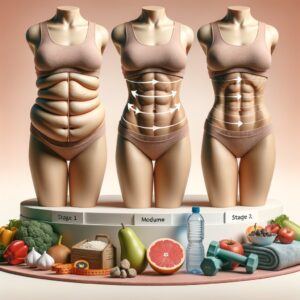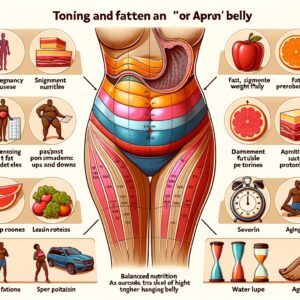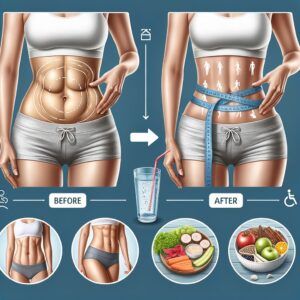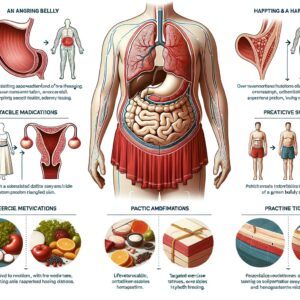Struggling with a hanging belly, also known as an apron belly, can be both physically uncomfortable and emotionally challenging. Whether it’s due to pregnancy, significant weight fluctuations, hormonal changes, or aging, many individuals find themselves searching for practical solutions to flatten and tone their midsection.
Fortunately, surgery isn’t the only option available—there are numerous practical strategies involving targeted exercises, nutritional adjustments, and lifestyle modifications that can help you achieve noticeable improvements naturally. In this comprehensive guide, we’ll explore everything from understanding the root causes of an apron belly to realistic timelines for achieving your desired results.

Don’t Wait for Change—Create It with GreatLife.
1. Understanding the Apron Belly: Causes, Types, and Appearance
An apron belly, medically known as panniculus or abdominal overhang, refers to excess skin and fat that hangs down from the abdomen. This condition can vary significantly in severity, from a slight droop of loose skin to a more pronounced fold that covers part or all of the pubic region. Understanding its causes is essential for addressing it effectively.
Several factors contribute to the development of an apron belly. Pregnancy is one common cause; during pregnancy, the abdominal muscles stretch extensively to accommodate fetal growth, often resulting in weakened muscle tone and stretched skin postpartum.
Significant weight fluctuations also play a critical role—rapid weight gain followed by substantial weight loss leaves behind excess skin unable to retract fully due to lost elasticity. Additionally, aging naturally reduces collagen production and elasticity within the skin tissues, exacerbating sagging around the midsection.
There are different types of apron bellies categorized primarily by their size and degree of overhang. Mild cases typically involve minimal loose skin with minor aesthetic concerns but little functional impairment.
Moderate cases present greater amounts of hanging tissue, which may cause discomfort or hygiene challenges due to friction between the folds of skin. Severe cases feature extensive overhanging tissue that can cause significant physical discomfort, such as chronic irritation or infections beneath the folds.
In appearance terms, an apron belly manifests visually as sagging lower abdominal tissue extending downward beyond typical anatomical boundaries, often creating emotional distress related not only to aesthetics but also practical issues like clothing fit difficulties or mobility restrictions during daily activities and exercise routines. Recognizing these distinctions helps individuals better understand their specific situation when considering targeted interventions for improvement moving forward.

Transform Your Health and Finances—Start with GreatLife Today!
2. Can You Eliminate an Apron Belly Without Surgery?
Eliminating an apron belly without surgical intervention is achievable, although it requires consistent effort, patience, and realistic expectations. Non-surgical methods primarily involve lifestyle modifications such as dietary adjustments, targeted exercise routines, and weight management strategies. These approaches can significantly reduce excess fat deposits and improve skin elasticity over time.
Dietary changes are foundational in addressing a hanging belly naturally. Reducing caloric intake while emphasizing nutrient-dense foods rich in protein, fiber, vitamins, and healthy fats supports gradual weight loss and promotes skin health. Hydration also plays a crucial role; drinking sufficient water daily enhances skin elasticity and aids digestion.
Exercise regimens that combine cardiovascular activities with strength training exercises targeting the abdominal region can effectively tone underlying muscles and tighten loose skin. Core-strengthening workouts, such as planks, crunches, leg raises, Pilates movements, or yoga poses, specifically target the abdominal muscles to firm up the midsection progressively.
Additionally, incorporating lifestyle habits such as stress-reduction techniques—like meditation or deep breathing exercises—and ensuring adequate sleep helps regulate cortisol levels, which directly influence fat storage in the abdominal area.
However, it’s essential to acknowledge that individual results may vary due to factors such as age-related collagen depletion, which affects skin elasticity levels after significant weight loss, or pregnancy-induced tissue stretching in this region. While non-invasive treatments like radiofrequency therapy or ultrasound cavitation may offer supplementary benefits by stimulating collagen production and improving firmness over time, these options should be discussed thoroughly with qualified professionals before proceeding with treatment plans explicitly tailored to personal goals regarding apron belly elimination without surgery involvement.

Unlock Your Potential—Start Your GreatLife Journey Today!
3. Effective Exercises for Tightening Loose Belly Skin and Reducing Overhang
Incorporating targeted exercises into your fitness routine can significantly improve the appearance of loose belly skin and reduce abdominal overhang. Strength training exercises that focus on building core muscles, such as planks, crunches, and leg raises, are efficient in tightening the midsection.
Planks engage multiple muscle groups simultaneously, strengthening not only the rectus abdominis but also the deeper stabilizing muscles, such as the transverse abdominis. Aim to hold plank positions for 30–60 seconds per set, gradually increasing duration as strength improves.
Crunch variations—such as bicycle crunches or reverse crunches—also effectively target lower abdominal muscles where excess skin often accumulates. Performing three sets of 15–20 repetitions several times a week can yield noticeable improvements in tone and firmness over time.
Resistance training with weights or resistance bands further enhances muscle definition beneath loose skin by stimulating collagen production and improving overall elasticity. Exercises like Russian twists using medicine balls or weighted sit-ups encourage greater muscular engagement while promoting tighter skin around the abdomen.
Additionally, incorporating cardiovascular activities such as cycling or swimming helps burn fat layers beneath loose skin more efficiently than strength training alone. Combining aerobic exercise with targeted core workouts accelerates results by reducing body fat percentage while simultaneously toning underlying musculature.
Consistency is crucial when aiming to tighten belly skin through exercise; regular practice ensures sustained progress toward achieving desired outcomes. For optimal results, aim for at least three weekly sessions that combine cardio activity and focused abdominal exercises tailored specifically to address concerns about a hanging belly.
4. Walking Your Way to a Flatter Stomach: Myth or Reality?
Walking is often touted as an accessible and effective method for weight loss, but can it truly help flatten a hanging belly? The reality lies somewhere between myth and truth. While walking alone may not specifically target abdominal fat, incorporating regular brisk walks into your daily routine significantly contributes to overall body fat reduction, including the stubborn apron belly.
Engaging in consistent cardiovascular exercise, such as walking, boosts metabolism, burns calories, and promotes gradual weight loss. As you lose excess pounds from all over your body through sustained aerobic activity, you will inevitably notice improvements around your midsection. Moreover, walking helps regulate insulin sensitivity and cortisol levels—two factors closely linked with abdominal fat accumulation.
To maximize results from walking routines aimed at toning the stomach area, consistency and intensity are crucial. Aim for at least 30 minutes of moderate-intensity brisk walking five days per week or more if possible. Gradually increasing duration or pace can further enhance calorie burn and accelerate progress toward reducing belly overhang.
Additionally, combining regular walks with strength training exercises that target core muscles provides even greater benefits by tightening the underlying muscle tissue beneath loose skin layers. This dual approach ensures that while you’re losing fat through cardio activities like walking, you’re simultaneously building stronger abdominal muscles that can support a firmer skin appearance.
In summary, although simply taking strolls won’t magically eliminate an apron belly overnight, integrating purposeful brisk walks regularly alongside targeted strengthening workouts makes achieving noticeable improvement a realistic rather than a mythical aspiration.

Transform Your Health and Finances—Start with GreatLife Today!
5. Hormonal Bellies Explained: Menopause, PCOS, Cortisol, and Alcohol Impact
Hormones play a significant role in the accumulation of belly fat, particularly when it comes to conditions such as menopause and polycystic ovary syndrome (PCOS). During menopause, estrogen levels decline sharply, causing fat distribution to shift toward the abdomen. This hormonal change often results in increased visceral fat storage around internal organs, contributing to a pronounced belly overhang, also known as an apron belly.
Similarly, women with PCOS experience elevated androgen levels and insulin resistance that can lead to abdominal weight gain. Insulin resistance prompts the body to store excess glucose as fat around the midsection rather than burning it for energy. Managing insulin sensitivity through dietary adjustments and regular exercise is crucial for reducing this type of hormonal belly.
Cortisol—the body’s primary stress hormone—also significantly impacts abdominal fat accumulation. Chronic stress elevates cortisol production, prompting the body to store more visceral fat around vital organs as an evolutionary protective mechanism. Practicing mindfulness through activities such as meditation or yoga can help reduce stress and lower cortisol levels, which in turn can lead to a decrease in abdominal obesity.
Alcohol consumption further exacerbates hormonal imbalances by interfering with metabolic processes within the liver. Excessive alcohol intake increases estrogen dominance while simultaneously impairing proper metabolism of fats and sugars; this combination encourages additional storage of visceral adipose tissue around the waistline.

Take Charge of Your Health—One Supplement at a Time.
6. Nutritional Secrets for Shrinking Your Waistline Quickly and Safely
Achieving a flatter belly requires more than exercise; nutrition plays a crucial role in reducing abdominal fat and tightening loose skin. Incorporating specific dietary strategies can accelerate your progress safely and sustainably.
First, prioritize lean proteins such as chicken breast, fish, eggs, legumes, and tofu to support muscle growth and repair while promoting satiety throughout the day. Protein-rich foods help maintain muscle mass during weight loss, preventing sagging skin that often accompanies rapid fat reduction.
Next, emphasize fiber-rich vegetables like broccoli, spinach, kale, Brussels sprouts, carrots, and bell peppers in every meal. Fiber not only aids digestion but also reduces bloating by regulating bowel movements and stabilizing blood sugar levels, key factors in shrinking waist circumference quickly yet healthily.
Additionally, healthy fats from sources like avocados, nuts (almonds or walnuts), seeds (chia or flaxseeds), olive oil, or fatty fish such as salmon provide essential nutrients necessary for hormone regulation—a crucial aspect of targeted belly-fat loss efforts. Omega-3 fatty acids found abundantly in these foods have been shown to reduce inflammation associated with excess abdominal fat storage.
Limiting processed carbohydrates, including refined sugars commonly found in baked goods and sugary beverages, is another vital nutritional secret for achieving a toned midsection rapidly without compromising overall health standards. Instead, opt for complex carbs derived naturally from whole grains such as quinoa or brown rice, which release energy gradually into your bloodstream, avoiding insulin spikes linked directly with increased visceral adiposity around the abdomen area.
Finally, ensure adequate hydration daily through water intake, alongside green tea consumption, which is widely recognized for its metabolism-enhancing antioxidant properties. This can significantly assist in achieving quicker yet safe waistline reduction goals over time when combined consistently with balanced dietary habits outlined above.
7. Realistic Timelines and Expectations for Achieving a Flat Belly
Achieving a flatter, toned belly is an attainable goal, but it requires patience, consistency, and realistic expectations. The timeline for noticeable results varies significantly depending on factors such as age, genetics, current fitness level, dietary habits, and the extent of abdominal overhang. Generally speaking, most individuals can expect to see initial improvements within four to six weeks of consistent exercise and dietary changes; however, substantial transformations typically require three to six months or longer.
For those dealing with significant loose skin or pronounced apron belly due to weight loss or pregnancy-related stretching of the abdominal area, progress may initially appear slower. In these cases, especially, it’s important to set achievable short-term goals that focus on incremental improvements rather than immediate dramatic change.
Consistent strength training exercises that target core muscles, combined with cardiovascular activities, will gradually enhance muscle tone beneath the skin surface while promoting fat reduction.
Additionally, nutritional adjustments play a critical role in determining how quickly you achieve your desired outcome. Adopting balanced eating habits rich in lean proteins and fiber while reducing processed foods accelerates fat loss around the midsection more effectively than exercise alone.
Ultimately, understanding that flattening an apron belly isn’t an overnight process helps maintain motivation throughout your journey toward improved body confidence. Setting realistic timelines—typically several months—and celebrating small milestones along the way ensures sustained commitment without frustration from unrealistic expectations.

Unlock Peak Performance—Personalized Nutrition Starts Here.
Conclusion:
Flattening and toning a hanging belly is achievable through consistent effort in exercise routines tailored specifically toward strengthening core muscles, combined with strategic dietary choices aimed at reducing abdominal fat safely. By incorporating regular cardiovascular activities such as brisk walking alongside strength training exercises like planks and crunches—and by making mindful nutritional decisions—you’ll set yourself on a clear path toward lasting improvement.
Remember that patience is key; meaningful progress typically unfolds over several months rather than overnight transformations. Stay committed to your goals while maintaining realistic expectations along the way—your dedication will ultimately reward you with increased confidence and improved overall well-being.

